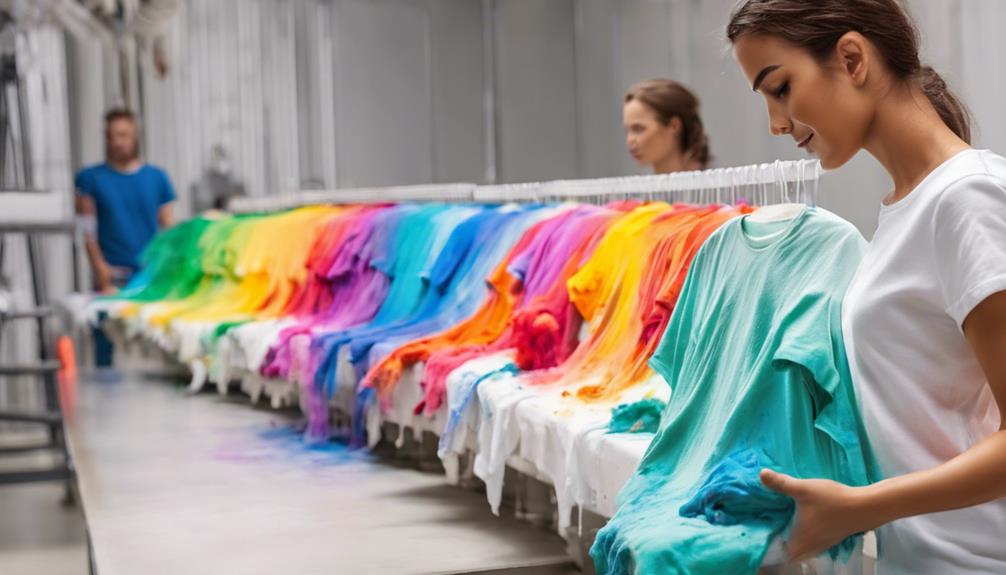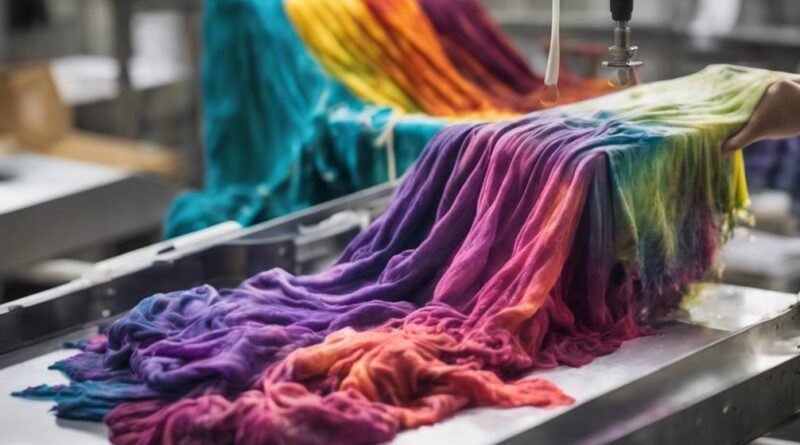Revolutionizing Sustainable Fashion: Eco-friendly Fabric Dyeing Techniques
When it comes to revolutionizing sustainable fashion, exploring eco-friendly fabric dyeing techniques opens up a world of possibilities.
Natural plant-based dyes, biodegradable dyeing agents, and waterless dyeing technologies are just the beginning of the innovative approaches reshaping the industry.
The quest to minimize environmental impact while maintaining vibrant, long-lasting colors has led to intriguing advancements in solar-powered dyeing processes, microorganism-assisted dyeing, and more.
As the fashion world embraces these eco-conscious practices, the future of fabric dyeing holds promise for a greener tomorrow.
Natural Plant-based Dyes
If you're looking to create eco-friendly fabrics, natural plant-based dyes offer a sustainable and vibrant alternative to traditional chemical dyes. These dyes provide a wide range of sustainable colors derived from botanical pigments, making them an excellent choice for environmentally conscious fabric dyeing.
Botanical pigments, found in plants like turmeric, indigo, and madder root, are the key to achieving sustainable color in fabric dyeing. These natural pigments not only produce beautiful and rich hues but also help reduce the negative impact of toxic chemicals on the environment. By utilizing plant-based dyes, you can create a more sustainable supply chain for your textile products.
When you opt for natural plant-based dyes, you aren't only choosing eco-friendly alternatives but also supporting the preservation of traditional dyeing techniques. Many communities around the world have been using botanical pigments for centuries, passing down their knowledge from generation to generation. By incorporating these methods into your fabric dyeing process, you contribute to the preservation of cultural heritage and sustainable practices.
Biodegradable Dyeing Agents
When exploring eco-friendly fabric dyeing techniques, a significant consideration is the use of biodegradable dyeing agents. These sustainable alternatives offer environmentally friendly options that not only reduce the carbon footprint but also minimize the harmful impact on ecosystems.
Here are three key points to understand the importance of biodegradable dyeing agents:
- Sustainable Alternatives: Biodegradable dyeing agents are derived from natural sources such as plants, minerals, or even biowaste, making them a sustainable choice for dyeing fabrics. By opting for these alternatives, you can contribute to a more sustainable and environmentally conscious fashion industry.
- Eco-Friendly Options: Unlike traditional synthetic dyes that contain toxic chemicals and heavy metals, biodegradable dyeing agents break down naturally without leaving behind harmful residues. This ensures that the dyeing process is more environmentally friendly and reduces the pollution caused by conventional dyeing methods.
- Reduced Environmental Impact: Using biodegradable dyeing agents helps in minimizing water pollution, as these agents don't release harmful substances into water bodies during the dyeing process. By choosing biodegradable options, you can actively participate in reducing the environmental impact of fabric dyeing and promote a cleaner, greener future for the fashion industry.
Waterless Dyeing Technologies
Exploring waterless dyeing technologies offers a sustainable and innovative approach to fabric coloring, revolutionizing traditional dyeing processes. Energy efficient dyeing methods are at the forefront of sustainable coloring techniques, significantly reducing water consumption and chemical usage in the dyeing process. By utilizing these waterless dyeing technologies, you can contribute to a more environmentally friendly fashion industry.
These energy efficient dyeing techniques rely on innovative processes such as air dyeing, dry dyeing, and coloration methods that eliminate the need for large amounts of water traditionally used in fabric dyeing. Air dyeing, for example, uses air pressure to infuse pigments into the fabric without the necessity of water, resulting in vibrant and long-lasting colors while reducing water waste. Dry dyeing techniques involve the use of supercritical CO2 to apply dyes to fabrics, offering a more sustainable alternative to traditional water-based dyeing methods.
Solar-Powered Dyeing Processes
Solar power drives the innovative dyeing processes in eco-friendly fabric coloring techniques. By harnessing renewable energy sources like the sun, textile industries are revolutionizing their dyeing practices to become more sustainable. Here's how solar-powered dyeing processes are changing the game:
- Reduced Carbon Footprint: Solar-powered dyeing processes significantly decrease the carbon footprint of fabric production by eliminating the need for fossil fuels to power traditional dyeing methods. This shift towards renewable energy sources aligns with sustainable practices and helps combat climate change.
- Cost-Effective Solutions: Implementing solar-powered dyeing processes can lead to long-term cost savings for textile manufacturers. While the initial investment in solar infrastructure may be significant, the reduced reliance on conventional energy sources can result in lower operational costs over time.
- Environmental Benefits: Solar-powered dyeing processes offer environmental benefits beyond reducing greenhouse gas emissions. By utilizing clean energy sources, textile industries can minimize water pollution, energy waste, and overall environmental impact. These sustainable practices not only benefit the planet but also cater to the increasing consumer demand for eco-conscious products.
Microorganism-Assisted Dyeing
Incorporating microorganisms into the dyeing process enhances the sustainability of fabric coloring techniques. By utilizing a bacteria culture in the dyeing process, sustainable pigments can be produced, reducing the environmental impact of traditional dyeing methods.
Bacteria culture plays a vital role in microorganism-assisted dyeing. These cultures can be manipulated to produce a wide range of colors, offering an eco-friendly alternative to synthetic dyes. By harnessing the natural pigmentation capabilities of certain bacteria strains, fabric dyeing can be achieved without the need for harmful chemicals.
The use of sustainable pigments derived from microorganisms not only minimizes the carbon footprint but also reduces water pollution. Unlike conventional dyeing processes that involve toxic substances, microorganism-assisted dyeing is a cleaner and greener solution for the fashion industry.
Furthermore, this innovative approach promotes the circular economy by utilizing biological resources that can be easily replenished. By tapping into the power of microorganisms, fabric dyeing can become more environmentally friendly and socially responsible.
Recycled Water Dyeing Systems
Utilizing recycled water in dyeing systems significantly reduces water consumption and environmental impact in the fabric coloring process. Here's why you should consider implementing recycled water dyeing systems:
- Conservation of Water Resources: By recycling water in dyeing processes, you contribute to preserving freshwater sources and reduce the strain on local water systems. This practice aligns with sustainable water management practices and helps in mitigating water scarcity issues.
- Lower Environmental Impact: Recycled water dyeing systems minimize the discharge of pollutants into the environment. By reusing water for dyeing fabrics, you can decrease the contamination of natural water bodies with harmful chemicals, promoting a cleaner ecosystem.
- Cost-Effective Solution: Implementing recycled water dyeing systems can lead to cost savings in the long run. By reducing the need for fresh water intake and wastewater treatment, companies can lower their operational expenses while enhancing their sustainability efforts.
Non-toxic Enzyme Treatments

Considering the growing emphasis on sustainability in fabric dyeing processes, embracing non-toxic enzyme treatments presents a promising eco-friendly alternative. Enzymes are biodegradable proteins that act as catalysts to modify fabrics without the need for harmful chemicals. This approach aligns with the principles of enzyme sustainability, promoting a greener way to dye textiles.
Non-toxic solutions, such as enzyme treatments, offer multiple benefits for both the environment and the textile industry. By using enzymes, manufacturers can achieve vibrant colors and unique effects on fabrics while significantly reducing water consumption and energy usage in the dyeing process. Moreover, these treatments minimize the release of toxic substances into waterways, preserving aquatic ecosystems and supporting a healthier planet.
Enzyme sustainability in fabric dyeing also extends to the reduction of waste generated during production. Enzymatic treatments can enhance the efficiency of dye fixation on fibers, resulting in less dye wastage and a lower environmental impact. This eco-friendly approach not only improves the overall sustainability of textile manufacturing but also addresses the increasing consumer demand for ethically produced and non-toxic garments.
Digital Dyeing Innovations
To revolutionize fabric dyeing processes and further enhance sustainability efforts, explore the cutting-edge realm of Digital Dyeing Innovations. Digital dyeing techniques are paving the way for a more environmentally friendly approach to coloring fabrics. By utilizing innovative technologies like virtual reality dyeing and smart fabric coloring, the fashion industry can significantly reduce its environmental footprint.
Here are three game-changing aspects of Digital Dyeing Innovations:
- Virtual reality dyeing: Step into a virtual world where dyeing processes can be simulated and optimized before any actual dye comes into contact with fabric. Virtual reality dyeing allows for experimentation with different color combinations and dyeing techniques without wasting resources on physical samples. This not only saves time and money but also minimizes the environmental impact of traditional trial and error methods.
- Smart fabric coloring: Imagine fabrics that can change color with just a tap on your smartphone. Smart fabric coloring involves embedding color-changing pigments or dyes that can be controlled remotely. This technology not only adds a fun and interactive element to fashion but also promotes sustainability by reducing the need for multiple garments in different colors.
- Precision dyeing: Digital dyeing innovations enable precise application of color, ensuring minimal dye waste and water usage. By targeting specific areas of the fabric with color, manufacturers can achieve intricate designs with minimal environmental repercussions. This level of precision also results in higher quality products and reduces the likelihood of dye runoff into water sources.
Frequently Asked Questions
Can Eco-Friendly Fabric Dyeing Techniques Reduce Water Consumption in the Fashion Industry?
By using eco-friendly fabric dyeing techniques, you can significantly reduce water consumption in the fashion industry. These methods prioritize energy efficiency and cost effectiveness while also positively impacting the environment.
How Do Natural Plant-Based Dyes Compare in Terms of Color Fastness and Durability to Traditional Synthetic Dyes?
When comparing natural plant-based dyes to traditional synthetic dyes, you might wonder about color fastness and dye durability. Natural dyes can offer rich hues, but typically have lower color fastness compared to synthetic dyes.
However, with proper mordants and techniques, natural dyes can also exhibit good color retention and durability. Experimenting with different plant sources and dyeing methods can help achieve desired results in eco-friendly fabric dyeing.
Are There Any Limitations or Challenges Associated With Implementing Biodegradable Dyeing Agents on a Large Scale?
When implementing biodegradable dyeing agents on a large scale, you might encounter limitations and challenges. Scalability could pose issues as the demand grows. Implementing these agents may require significant adjustments to current dyeing processes.
Biodegradable options might have different performance characteristics compared to traditional dyes, impacting color vibrancy or durability. Ensuring consistent quality and availability of these eco-friendly agents could be crucial for successful implementation in the fashion industry.
What Types of Fabrics Are Most Suitable for Waterless Dyeing Technologies?
When it comes to fabric selection for waterless dyeing technologies, look for materials like polyester, nylon, and modal.
These fabrics work well with the dyeing process, ensuring dyeing efficiency and vibrant color outcomes.
By choosing these types of fabrics, you can optimize the benefits of waterless dyeing techniques while reducing environmental impact.
Selecting the right fabrics plays a crucial role in successful implementation of sustainable dyeing practices.
How Do Microorganism-Assisted Dyeing Processes Impact the Overall Carbon Footprint of the Fashion Industry?
When considering microorganism-assisted dyeing processes, you can significantly reduce the overall carbon footprint of the fashion industry.
These methods leverage the efficiency of microorganisms to dye fabrics in a sustainable way.
Conclusion
You have learned about the exciting advancements in sustainable fashion through eco-friendly fabric dyeing techniques. By incorporating natural plant-based dyes, biodegradable agents, waterless technologies, and innovative processes like solar-powered and microorganism-assisted dyeing, the fashion industry is making strides towards a more environmentally-friendly future.
With the use of recycled water systems, non-toxic enzyme treatments, and digital dyeing innovations, we can all contribute to reducing the environmental impact of fashion production. Together, we can revolutionize sustainable fashion for a better world.
